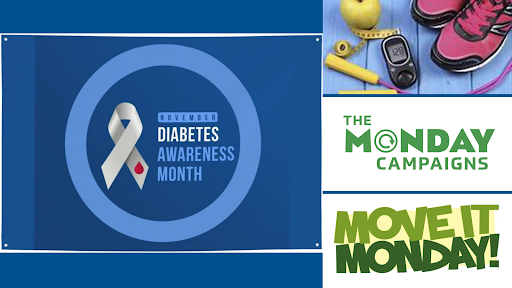Stay Active and Healthy. Prevent and Manage Diabetes
November is Diabetes Awareness Month, a time to focus on preventing and managing this chronic condition. Did you know that regular physical activity is a powerful tool in your diabetes management arsenal? This week’s article explores how exercise can help prevent diabetes and benefit individuals with diabetes. Strategies will be provided to overcome common barriers to getting active.
The Power of Movement
Research shows that regular physical activity can significantly improve blood sugar; reduce the risk of heart disease, a common complication of diabetes; and promote overall well-being. The American Diabetes Association (ADA) recommends aiming for at least 150 minutes of moderate-intensity exercise per week, which can be broken down into smaller, more manageable chunks.
Exercise to Prevent Diabetes
Movement is an important factor in preventing diabetes, and if you have prediabetes, you can lower your risk of developing type 2 diabetes by getting regular physical activity. The ADA provides the following guidance on getting to that 150-minute mark weekly.
Breaking Down Barriers to Physical Activity
Don’t Let Excuses Get in the Way. Many people face challenges when trying to incorporate regular physical activity into their lives. However, with a little creativity and determination, you can overcome these barriers and reap the benefits of exercise.
Start Small, Dream Big:
- Gradual Progress. Begin with short, manageable workouts and gradually increase the duration and intensity.
- Free and Easy. Incorporate physical activity into your daily routine with simple activities like walking, gardening or dancing.
- Consult Your Doctor. Seek guidance from your healthcare provider to identify suitable activities and potential limitations.
- Everyday Activity. Make conscious choices to be more active throughout the day, such as taking the stairs, parking farther away or standing during phone calls.
- Know Your Numbers. Particularly for diabetics, track your blood sugar levels before and after exercise to understand how physical activity affects your glucose control.
- Exercising with Diabetes Complications
The American Diabetes Association (ADA) provides guidelines for safe and effective exercise tailored to specific diabetes-related conditions. Key points to remember:
- Consult Your Healthcare Team. Before starting any new exercise regimen, it’s crucial to consult with your doctor or a certified diabetes educator.
- Choose Low-Impact Activities. Opt for activities like walking, swimming and cycling, which are gentle on your joints.
- Listen To Your Body. Pay attention to your body’s signals and avoid pushing yourself too hard.
- Stay Hydrated. Drink plenty of water, especially during and after exercise.
- Check Your Feet Regularly. If you have peripheral neuropathy (numbness), inspect your feet daily for any signs of injury or infection.
This Monday’s Tip: Start Your Week With Physical Activity
During Diabetes Awareness Month, it’s especially important to recognize the positive impact of physical activity in preventing and managing diabetes. Kick off your week with some physical activity to set a positive tone for the days ahead. Whether it’s a brisk walk, a quick workout, or even a dance session in your living room, getting active is a fantastic way to boost your energy and mood.
There are great options at your doorsteps. Revisit Monday Campaigns’ Move It Monday: Fall Fitness Fun—Keep Moving and Embrace Autumn! to find inspiration for today’s activity.
Feeling Inspired and Ready to Level Up?
- Revisit the “Available Employee Resources for Awareness, Prevention and Treatment” section of last week’s article: November is American Diabetes Month: Know Your Status for information on benefits available to prevent and treat diabetes.
- Resource Spotlight. The CDC-led National Diabetes Prevention Program can help you make those changes—and make them stick. Through the program, you can lower your risk for type 2 diabetes by 58% (71% if you’re over age 60). Ask your doctor and/or your health care plan’s member services if there’s a CDC-recognized National Diabetes Prevention Program offered in your community, or find a program. The best time to prevent type 2 diabetes is now.

Submitted by:
Dahlia Henry-Tett, Chief Wellness Officer (CWO), employeewellbeing@nvcc.edu
